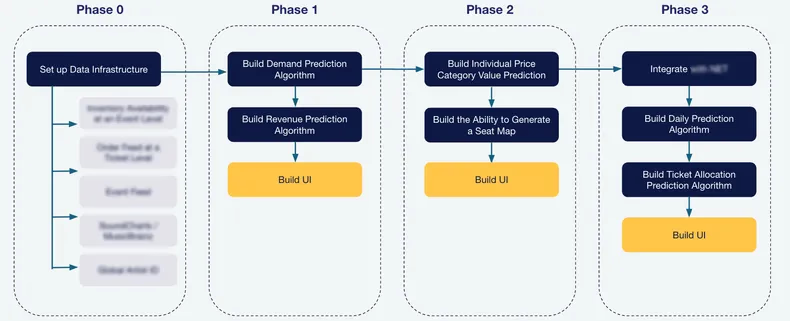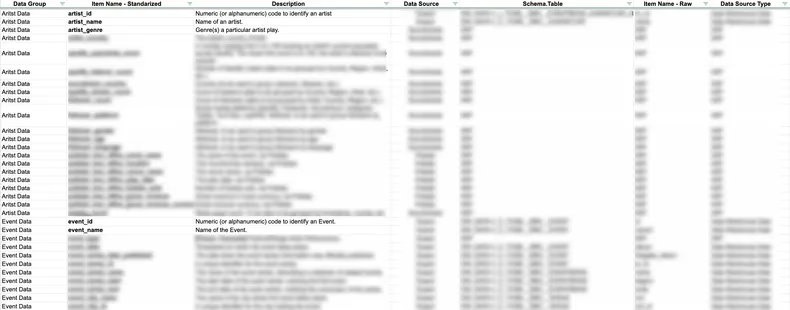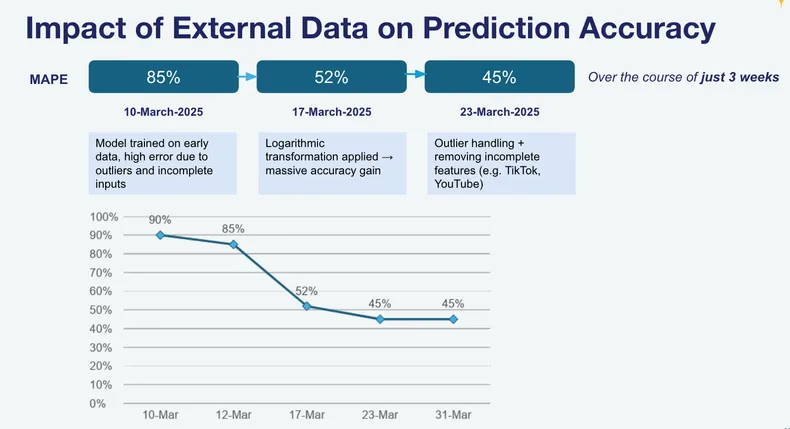Product People Built the Foundation for the Global Live Entertainment and Ticketing Leader's Dynamic Pricing Strategy
About how we defined and implemented a phased rollout plan for predictive pricing

The Client: Global Live Entertainment and Ticketing Leader
Our client is a leading European ticketing provider and global entertainment platform, selling hundreds of millions ****of tickets annually. The company powers concerts, festivals, and cultural events across Europe through its digital platforms and event management teams. In 2024, our client aimed to create a data-informed pricing platform to help promoters optimize ticket prices throughout the sales cycle.
The Mission: Interim Product Manager for Pricing and Growth Monetization
Our client, as a major player in the ticketing and event management space, has decades of historical pricing data. However, this gold mine of data was scattered and inconsistently structured across multiple platforms, and was not being harnessed for strategic initiatives such as dynamic pricing.
Most promoters relied on manual price setups, which were time-consuming, difficult to standardize, and failed to leverage available demand signals. Meanwhile, industry competitors were increasingly investing in dynamic pricing.
To keep pace and unlock value from internal data, our client brought in Product People to define a predictive pricing strategy from the ground up. The initiative aimed to build a scalable, data-informed pricing platform tailored to promoters’ needs. With fragmented systems across markets and no internal team driving this, we focused on creating a phased rollout approach—starting in one core market and expanding outward, anchored in feasibility, clarity, and stakeholder alignment.
🚀 Our Main Quest: Build a Demand Prediction and Dynamic Pricing Platform
🌐 Launch: Framing the Strategy and Validating What’s Worth Building
To define the problem and the desired solution, we first had to understand the dynamics of the market. We did that by:
- Competitive benchmarking across adjacent industries (live entertainment, travel, e-commerce).
- Interviewing 14+ internal stakeholders and event promoters.
This helped define what was feasible, identify technical dependencies, and align stakeholders around three clear validation phases:
- Phase 0: Define foundational ingestion logic and consolidate internal data
- Phase 1: Build MVP tools for demand prediction and price simulation
- Phase 2: Integrate with seat maps, GA4, and promoter tools for validation
This plan created cross-functional alignment and became the backbone for execution.

🔧 Solved for the Client: Setting Up the Data Infrastructure for Ingestion and Modelling
Problem:To support predictive pricing, our client’s internal data needed to be leveraged. But the data was fragmented across tools, inconsistently structured by region, and often duplicated (e.g., multiple records for the same artist or venue). This made it difficult to model demand and suggest pricing strategies.
Solution:
- Onboarded a Data Scientist and a Data Engineer
- Defined ingestion logic for core event-related data (event details, orders, inventory, user behavior like favorites and alarms)
- Consolidated one core market data into a centralized Snowflake environment
- Ran feasibility modelling: initial MAPE was ~85%, exposing structural gaps
📚 📊 MAPE (Mean Absolute Percentage Error): A standard metric used to measure the accuracy of forecasting models. It represents the average percentage difference between predicted and actual values. Lower MAPE values indicate higher model accuracy—e.g., 10% MAPE means the model's predictions are off by 10% on average.
Outcome:The data mapping exercise enabled the identification of gaps in the structure and created a cohesive plan for building the technical foundation for internal modeling and future scalability across markets.

🔄 Solved for the Client: Improving Accuracy by Incorporating External Data Points
Problem:From the initial data exercise, it became apparent that internal data alone didn’t provide the desired accuracy. Many attributes were noisy or incomplete, and most markets weren’t yet ingested.
Solution:
- Integrated an external data enrichment partner to enrich the dataset with artist popularity signals
- Retrained the model on 2,000+ concerts with hybrid inputs
Outcome:
- We were able to significantly improve MAPE from 85% to 45% and laid the groundwork for future modeling refinement.
We also identified the importance of data points that could be leveraged for further improvement of the model.

🧪 Solved for the Client: Conducting Feasibility Check via a Lightweight MVP Prototype
Problem:
We wanted to make sure that we iteratively build the predictive model, have a way to visualise what we are building to stakeholders, and capture their feedback.
Solution:
- Built early a lightweight prototyping tool to test user-facing logic for forecasting and price category value estimation
- Ran internal feedback loops to validate the tool’s usability and output flow
Outcome:
We had a functional proof-of-concept, helping stakeholders see the concept in action even before engineering a full rollout.
🆔 Solved for the Client: Ensuring Cross-System Data Consistency by De-duplicating Artist IDs
Problem:Across all the different systems and platforms, the same artist could appear multiple times with inconsistent naming and IDs. What that meant was that we would have inconsistent and broken data for the predictive data modelling, and also for the consumption of the data for downstream usage.
Solution:
- Partnered with a third-party data services provider to define an algorithm that identifies duplicates and merges artist records
- Defined acceptance criteria for the evaluation of the algorithm
- Manually evaluated the performance of the algorithm by doing data sanity checks across internal and external platforms
- Iterated on the algorithm to bring the output within the defined acceptance criteria
- Defined a data ingestion framework that determines how downstream systems consume data based on the algorithm's confidence scores
Outcome:Created a scalable deduplication strategy essential for long-term system integrity.
🧩 Discovery Mini-Missions: Our Side Quests
While the main focus was dynamic pricing, we also contributed to three strategic initiatives that supported broader platform consistency:
- 📊 Web Reporting – Building a Cross-Market Reporting Framework:Mapped out the report types used by each market, clarified shared KPIs (e.g., ticket count, conversion rate), and proposed a unified schema for future reporting infrastructure. This aimed to answer: "If we were to build a central reporting database, what attributes should be there?"
- 🏛️ Standardizing Content & Venue ID Structures:Created schemas and ownership models for venue and event content. This addressed cross-market inconsistencies (e.g., duplicated venues and misclassified attractions) and laid the groundwork for better reporting, pricing, and feature development.
- 🔍 Vendor Benchmarking as Fallback Strategy:Evaluated vendors like Dynamo and Smart Pricer as a contingency plan in case internal development became infeasible. Compared their offerings against our MVP vision and our client’s long-term strategic needs.
🏆 Mission Achievements: Delivered Outcomes
💡 Defined a phased predictive pricing roadmap grounded in data and feasibility
💡 Completed initial ingestion and centralized schema development in Snowflake
💡 Improved forecasting accuracy from 85% to 45% via hybrid modeling
💡 Created a Global Artist deduplication strategy
💡 Delivered a lightweight prototype to validate concept feasibility
Space Crew of this Mission



For Clients: When to Hire Us
You can hire us as an Interim/Freelance Product Manager or Product Owner
It takes, on average, three to nine months to find the right Product Manager to hire as a full-time employee. In the meantime, someone needs to fill in the void: drive cross-functional initiatives, decide what is worth building, and help the development team deliver the best outcomes.
If you're looking for a great Product Manager / Product Owner to join your team ASAP, Product People is a good plug-and-play solution to bridge the gap.






